Egypt treasures looted
To save sites, citizens and researchers form human chains and
get inventive
|

Flanked by special forces, antiquities chief Zahi Hawass speaks
at Cairo’s Egyptian Museum Monday. Photograph by Tara
Todras-Whitehill, AP
|
As protesters in Egypt agitate for President Hosni Mubarak to step
down, the resulting chaos is providing cover for looters who are
pillaging the country’s museums and archaeological sites.
That chaos, though, is also galvanizing both Egyptologists and
everyday Egyptians. Many have formed human chains, established
unofficial check points, and even jury-rigged ways around Mubarak’s
Internet and cell phone shutdowns - all in the name of safeguarding
ancient Egyptian treasures.
In Cairo on Friday, looters broke into the Egyptian Museum, which was
“not well guarded,” according to Egypt’s top antiquities official, Zahi
Hawass. The museum is home of some 120,000 historical objects, including
a famous gold funerary mask of King Tut, officials say.
The looters damaged, but didn’t manage to steal, dozens of artifacts,
including a statue of King Tut standing atop a panther and two royal
mummies, whose heads fell off during the raid.
“A lot of the things that were broken off were gilded wood, so I
think they were after gold,” UCLA Egyptologist Willeke Wendrich told
National Geographic News.
“The restoration of those objects, even if all the parts are still
there, will be very difficult, time consuming, and costly,” she added.
“This is really fragile wood.”
Police officers and Cairo citizens apprehended the looters on
Saturday. The same day, everyday Egyptians locked arms and surrounded
the museum to prevent other would-be thieves from entering the museum,
according to news reports.
People power on the rise in Egypt
While reports of looting throughout Egypt are now widespread,
accounts of local Egyptians banding together to protect local historic
sites are also common.
In Alexandria, local youths organized themselves into groups that
directed traffic, protected neighbourhoods, and guarded public buildings
such as the Library of Alexandria.
Speaking from Luxor, once the ancient Egyptian city of Thebes,
Egyptologist Suzanne Onstine said she’s encouraged by news of Egyptians
coming together to protect local treasures, even defying the Mubarak
Government’s newly instated curfews to do so.
“There were reports that people were stealing guns from the police
stations and that they were going to the monuments,” said Onstine, who
is affiliated with the University of Memphis in Tennessee.
However, “they were unsuccessful in getting in because the local
people had formed barricades at some places.”
For anyone who has traveled in Egypt, such actions by local people
would not be surprising, said UCLA’s Willeke.
“There is a general appreciation in Egypt of its history and there’s
a very clear understanding that an important part of the country’s
income comes from tourism based on Egypt’s history,” she said.
Other Egyptian museums hit
But not all of Egypt’s museums and ancient sites have been quite so
well protected. The open-air museum in Memphis - a capital of ancient
Egypt just south of Cairo - was emptied of its treasures, according to
antiquities chief Hawass.
While an inventory of items damaged or stolen at Memphis is not
currently available, the site is famous for its large statue of Pharaoh
Ramses II and other sculptures.
Other museums, including the Coptic Museum and Manial Palace Museum
in Cairo as well as the Royal Jewelry Museum and Alexandria National
Museum in Alexandria, were all broken into.
Archaeologists are also reporting that tombs at more remote site,
such as the royal necropolises at Abusir and Saqqara, the site of
Egypt’s first stone pyramids, are being ransacked.
Hawass, reached by phone early Monday, dismissed such claims as being
exaggerated.
“The damage at Saqqara is not really much. I’m not worried at all.
Everything is going to be safe today and tomorrow the situation will be
finished,” said Hawass, also a National Geographic Society
explorer-in-residence.
According to Hawass, all 24 of Egypt’s museums are now “completely
safe,” guarded by Egypt’s army, and should be open again to the public
by this Friday at the latest.
Egypt treasures especially vulnerable
Other scholars hope Hawass is right.
“I am hopeful that the looting will come to an end. Hawass has
already implemented numerous security measures, but there are hundreds
of sites across Egypt, many of which lie in remote areas,” University of
Alabama-Birmingham Egyptologist Sarah Parcak said.
National Geographic News
Ancient
Egyptian artifacts damaged in looting
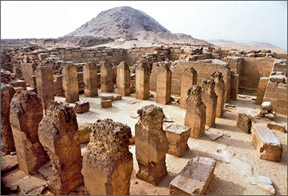 |
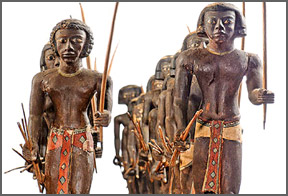 |
City of the Dead
In the region around this 4,500-year-old tomb of an official
at Abusir (pictured in an undated photo), looters allegedly
broke into excavation warehouses filled with artifacts this
past weekend. Egypt’s museums are so full of ancient
treasures that many excavated objects are stored near the
sites where they were found. In peaceful times a padlocked
door, lead seals marked with an inspector’s stamp, and a
guard are enough to keep them safe. Photograph by Werner
Forman, Corbis |
Line of Fire
Looters in the Egyptian Museum reportedly damaged
4,000-year-old models that represent an army of Nubian
archers (shown intact in a file picture). Standing about 21
inches (53 centimeters) tall, the statues were discovered in
1894 in the tomb of a prince in the town of Assiut.
Photograph by Kenneth Garrett, National Geographic |
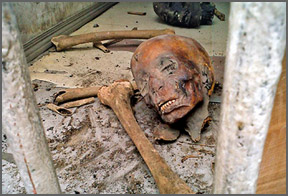 |
 |
Shattered
Two ancient mummified heads, as yet unidentified, lie on the
floor of the Egyptian Museum on Monday after the weekend
attack by looters. Photograph from AP |
Egyptian Museum
Tanks roll into Tahrir Square outside the Egyptian Museum in
Cairo on Sunday, January 30, 2011. During the chaotic
protests two nights before, would-be looters broke into the
108-year-old building through a skylight, according to
official reports. The vandals damaged mummies and artifacts
but were arrested before they could make off with anything.
Photograph by Tara Todra Whitehill, AP |
|
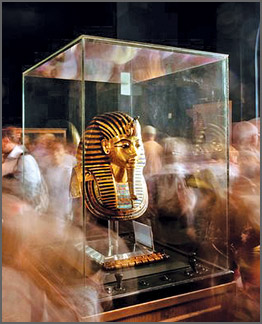 |
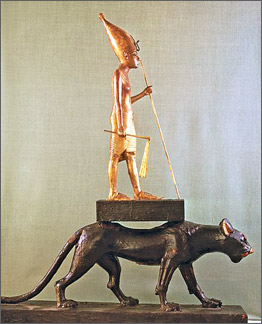 |
Face in the crowd
Shown in an undated picture, crowds throng King Tut’s golden
funerary mask in the Egyptian Museum. The iconic piece was
not among the damaged artifacts. Photograph by Kenneth
Garrett, National Geographic |
Before the break-in
Pictured in 1963, a 14th-century BC statuette from King
Tut’s tomb shows the young pharaoh balanced on the back of a
leopard. One of a matched pair, the sculpture was reportedly
damaged in the weekend attack on the Egyptian Museum.
Photograph by Roger Wood, Corbis |
|



